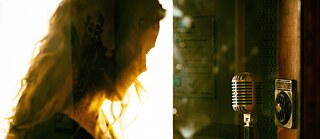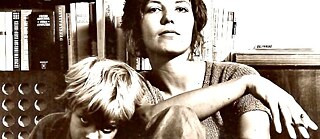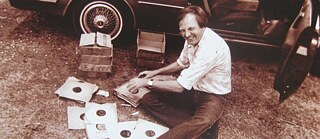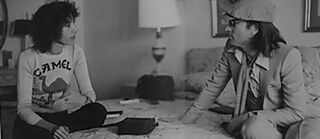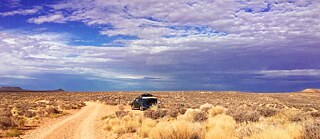The Mysterious History of Voice Mail
Record Booth
By the 1920s, people had begun using coin-operated record booths to create audio souvenirs — immortalizing their thoughts and feelings on a disc. Cariad Harmon travels to one of the last remaining record booths in Louisville, Kentucky, where she captures her own voice and revisits some touching messages from the past.
Listen to this episode: Apple Music | Spotify | Download
This story comes from Cariad Harmon, an independent radio producer, writer, and musician based in Nashville, Tennessee. Cariad is originally from Great Britain but now lives in Music City where she can pursue her passions. These days, she prefers making stories to making music, working as a producer at Great Feeling Studios alongside Jakob Lewis — a fellow producer for THE BIG PONDER. Find out more about Cariad’s work on her website. There are only a handful of Voice-O-Graph record booths left in existence — and only three that are open to the public in the United States. So, Cariad travels to Louisville, Kentucky, to visit a booth and record her voice. She speaks with Tom Levin, a professor at Princeton University who is on a mission to archive every audio letter he can find. She also talks with Bill Bollman, an engineer and expert on Voice-O-Graph machines. Most of the music featured in this episode was licensed via Blue Dot Sessions. The song “The Lucky One” was written and performed by Cariad herself. The other recordings featured in this piece come from Tom Levin’s and Bill Bollman’s archives and were used with their permission. Mike Maguire took the photo for this episode at Byrdland Records in Washington, D.C. “HowSound” spoke with Cariad about the making of “Record Booth” for THE BIG PONDER — listen to the full interview here.
Transcript
Cariad Harmon: This is Cariad Harmon with THE BIG PONDER.
Tom Levin: Okay, let’s do one more thing before we go downstairs. And that is: Let’s open a package.
Cariad Harmon: Professor Tom Levin is a media scholar working in the German department of Princeton University. And right now, he’s tearing into one of four packages that arrived from Ebay just this week.
[SOUNDS OF OPENING PACKAGES AND GIGGLING]
Tom Levin: [GIGGLES] This guy has done a good job of wrapping. Really a good job.
And then the ...
Cariad Harmon: You see, Tom is a collector with a capital “c.”
Tom Levin: To use the ugly term in collector language: I’m a completionist.
Cariad Harmon: And I’m here because, ten years ago, he made a discovery that has slowly taken over his mailbox and his life.
[MUSIC — “PALMS DOWN”]
Cariad Harmon: One Sunday morning back in 2011, Tom was browsing at his favorite local flea market when he found something he had never seen before. A small cardboard record inside a weathered envelope.
Tom Levin: And I brought it home, put it on my record player. And it turns out, it was a spoken letter from a soldier.
[RECORD PLAYING: HELLO MARY, THIS IS BUZZ SPEAKING. AXEL AND I ARE OVER AT THE USO BUILDING HERE AT EGLIN FIELD. WE’RE JUST LOAFING AROUND AS USUAL AND DECIDED TO MAKE USE OF THIS LITTLE GADGET THAT THEY HAVE HERE. BOY, I LOVE TO TALK ... ]
Cariad Harmon: The recording itself was mostly small talk, but Tom was fascinated. What gadget? What was this record even? And where had it come from?
Tom Levin: You know, I’m a scholar, so what scholars do is they start doing research and I went online and I went to the library and I checked all my sources. And to my astonishment, I could come up with nothing.
Cariad Harmon: As a media scholar, Tom has spent much of his career exploring the history of technology and sound. He’s written and translated books, curated exhibitions ... The guy teaches at Princeton. Yet neither he nor any of his colleagues knew anything about mailable records like this one.
Tom Levin: And so I started using Ebay and various Ebay-like sites all over the world and going to flea markets. And pretty soon, I was finding more and more of these discs.
[ARCHIVAL MUSIC RECORDING — “EVERYTIME IT RAINS”]
Cariad Harmon: As Tom searched, he found hundreds and hundreds of records, going back as far as the 1920s, and they were showing up all over the place. He found listings in Argentina, Australia, Belgium, Brazil, Canada, Germany, Luxembourg, Poland, Portugal, Taiwan ...
Tom Levin: And at a certain point, my wife thought I was having an affair because I was getting up at all hours of the night and going to my computer. She said, what are you doing? And when I explained to her that I was putting in bids for gramophonic letters, she found it a bit perplexing.
[MUSIC — “WELCOME HOME SONNY”]
Cariad Harmon: Tom had discovered the lost history of voice mail: gramophonic letters. For four decades, from the ’20s right up until the mid-’60s, people were recording their voices and mailing them to each other, right through the postal service. No telephones or computers required. Just a recording device and a stamp or two, and anyone could leave a message for a friend, family member, or long-distance lover anywhere in the world.
Cariad Harmon: Was that exciting to you as a collector?
Tom Levin: Yes! You feel like you’re doing pioneer work. It’s all new territory since everything remains to be discovered, right? It’s all fresh!
Cariad Harmon: So I’m assuming there’s a method to your, to your madness here. Can you talk me through how you’ve organized this?
Cariad Harmon: Soon after Tom began collecting, he received a generous grant to digitize, transcribe, and catalogue every gramophonic letter he could find. And today, ten years later, this tiny office in the German department at Princeton University is home to the Princeton Phono-Post Archive, the largest collection of audio letters in the world.
Tom Levin: It’s alphabetical, first by country.
[DRAWER OPENING]
Tom Levin: So the first drawer ...
Cariad Harmon: Some of the earliest recordings in Tom’s archive are steel discs made in the mid-1920s.
Tom Levin: ... prewar ...
[SOUND OF TOM RUMMAGING THROUGH FOLDERS]
Tom Levin: As a media theorist, they’re really interesting to me as a record of a moment in time when people are becoming accustomed to recording their voice. This was not something that people had had much experience with.
[ARCHIVAL RECORD PLAYING: HELLO! SO ALL’S WELL? HOW ARE YOU? DID YOU HAVE A GOOD TIME AT CAMP DEVENS THIS SUMMER? [SINGING] 25 YEARS FROM NOW BOYS, 25 YEARS FROM NOW ... ]
Cariad Harmon: It’s hard to put these recordings into context now, when each one of us is carrying a recording studio in our pocket. But back in the 1920s and ’30s, self-recording was still a very new concept, and the idea that you could mail your voice to someone else, like a letter or a photograph, was absolutely unheard of. And as Tom listened to these early recordings, he began to notice a trend. Lots of people seemed to be grappling with the same new idea: that a recording of the voice itself might outlive the speaker. They were using the records to memorialize themselves, leaving messages for loved ones to listen to in their absence.
[ARCHIVAL RECORD PLAYING: [SINGING] ... WHEREVER YOU ... ]
Tom Levin: I’m thinking in particular of a very moving recording, strange recording, done at the 1935 ‘Reichsrundfunkausstellung,’ the German Reich technology fair in Berlin.
[ARCHIVAL RECORD PLAYING IN GERMAN: SOLLTEN WIR EINMAL SPÄTER NICHT MEHR SEIN, SOLL DAS NUR EIN KLEINES ANDENKEN SEIN UND EUCH SAGEN, DASS WIR IMMER UND IMMER UM EUCH SEIN WOLLEN UND NUR EUER BESTES WOLLEN. UND EUCH, LIEBE JUNGEN ... ]
[MUSIC — “TOLLS FOLLY” PLAYS UNDERNEATH ARCHIVAL RECORDING]
Cariad Harmon: This woman steps up to the microphone with her husband and addresses her two sons. She says: “If later on, we’re no longer around, let this be a small souvenir, letting you know that we will want to be around you for ever and ever, and only want to do our best, dear boys, to bring you up as capable German men. That is our greatest wish. And may our blessing be always with you.”
Tom Levin: It’s like a weird audio-testament, it’s like a will.
[MUSIC — “TOLLS FOLLY” PLAYS AND THEN FADES OUT]
Cariad Harmon: The year this recording was made, the entire city of Berlin would have been rich with Nazi propaganda. Hitler, already chancellor, had become the Führer and new laws were passed, stripping Jewish people of their citizenship and designating them as subjects of the state. The march to war had begun and soldiers on both sides of the Atlantic would soon find a new use for these gramophonic letters. In December of 1941, the United States officially entered World War II and millions of young men from all over the country were sent to military training camps far away from home. Long-distance phone calls were impossibly expensive. We’re talking hundreds of dollars in today’s money, so brands like Pepsi Cola and Gems Razors sponsored recording stations. And thousands of soldiers mailed records home to families, anxiously awaiting news.
[ARCHIVAL RECORD PLAYING: HELLO, MOM AND DAD. WELL, IT’S BEEN SEVEN MONTHS NOW SINCE YOU HAVE HEARD MY VOICE. SO, HERE IT GOES [MUSIC — “HICKORY INTERLUDE” PLAYS]: I HOPE YOU ALL ARE WELL. DAD, I WANT YOU TO TAKE IT EASY IN THIS HOT WEATHER ... AND YOU TOO, MOM.]
[ARCHIVAL RECORD PLAYING: I WOKE UP THIS MORNING WITH THE FEELING THAT SOMETHING UNUSUAL WAS GOING TO HAPPEN, BUT I DIDN’T EXPECT TO BE STANDING IN FRONT OF A MICROPHONE SENDING MY VOICE TO BOTH OF YOU BACK HOME.]
[ARCHIVAL RECORD PLAYING: WE’RE HAVING A LOT OF FUN UP HERE, ME AND A COUPLE OF MY BUDDIES. ONLY BEEN OFFSHORE FOR THE FIRST TIME. THEY KEEP US PRETTY BUSY WHERE WE’RE AT. BUT WE GET ALL WE CAN TO EAT, SO WE WON’T HAVE TO WORRY ABOUT HOW WE’RE GOING TO EAT.]
[ARCHIVAL RECORD PLAYING: I SURE WISH I COULD MAKE IT FOR CHRISTMAS. THIS RECORD WILL HAVE TO SERVE AS A SUBSTITUTE FOR A COUPLE OF MONTHS ’CAUSE THAT’S ALL IT IS BETWEEN YOU AND ME.]
[ARCHIVAL RECORD PLAYING: WHAT’S THIS ABOUT YOU NOT FEELING TOO HOT LATELY? YOU KNOW BETTER THAN TO FEEL BAD WHEN I’M NOT AROUND. WE’VE GOT A QUARTET HERE: TWO OF THE CHAPLAINS AND A COUPLE OF THE FELLOWS CAN SING. HOW DO YOU SAY WE PUT THAT ON THE OTHER SIDE HERE? I GUESS MAYBE YOU FOLKS COULD GET A KICK OUT OF THAT.]
[ARCHIVAL MUSIC: QUARTET SINGING “THERE’S NO PLACE LIKE HOME”]
[ARCHIVAL RECORD CONTINUES: I GOT ABOUT TEN MORE SECONDS, I MISS YOU VERY MUCH HONEY, AND THAT’S ABOUT ALL I CAN SAY. I’D SING BUT I CAN’T SING. GOODBYE AND I LOVE YOU AND I MISS YOU.]
Cariad Harmon: I’ve listened to 30 or so military records from Tom’s archive, and mostly I’m struck by how young the speakers are. How many boys are leaving messages for their mothers and making promises to their girlfriends. Of course, most of these discs were sold by third parties. And we’ll never know which of these soldiers actually made it home.
[ARCHIVAL MUSIC: QUARTET SINGING “THERE’S NO PLACE LIKE HOME” ENDS]
Cariad Harmon: Surprisingly, very few of these recordings say much about the war at all. In contrast to the earlier discs, there are no great reckonings with mortality here. No solemn promises or last words before the front. They are mostly small talk, jokes about the food, questions for the folks back home.
Tom Levin: We need to listen not only to what is said but what is unsaid. Maybe it’s the insistence, the prevalence of phrases like “Boy, can’t wait to taste your food again, Mom,” “Boy, can’t wait to drive in that car again, Bob,” that it has to be read as an expression of an anxiety of, I hope not only this voice of mine arrives in your living room but that I too will one day be able to return.
Cariad Harmon: It’s hard not to wonder how these military letters in particular ended up in Tom’s archive. It’s clear that someone cherished each one enough to preserve it. But over the years, they were all passed down and forgotten. And eventually, Tom picked most of them up on Ebay for just a few dollars each.
Tom Levin: [RUSTLING THROUGH ARCHIVE] Uh ... Ha! Here we go, here we go, here we go! These are all Nazi voice letters.
Cariad Harmon: Of course, it wasn’t just American soldiers who had access to this kind of technology. German soldiers recorded voice mails for their families too.
Tom Levin: [FLIPPING THROUGH ARCHIVE] ‘Der sprechende Feldpostbrief,’ ‘The speaking letter from the front.’ These are particularly interesting. In the center where there’s a label, you have the photograph of the person speaking.
Cariad Harmon: Oh that is the actual person on the ...
Tom Levin: That’s the actual person on the ...
Cariad Harmon: Oh, that’s amazing!
Tom Levin: Isn’t that amazing? Here’s ...
Cariad Harmon: Tom has carefully pulled a disc from a folder in his filing cabinet. It’s pale yellow and delicate, covered in a thin layer of laminate. At the center, is a faded black-and-white photograph of a young Nazi soldier in uniform speaking into a microphone.
Tom Levin: And what’s really interesting about it is, we have the person speaking, we have their voice, and we don’t know who they are, right? So we have these incredibly powerful traces of their individuality, but we don’t know who they are.
[ARCHIVAL RECORD PLAYING IN GERMAN: SO, NUN IHR LIEBEN, HABEN WIR AUCH ETWAS MUSIK HIER. MEIN KAMERAD WILLY VON DER KOMPANIE WIRD EUCH JETZT EIN LIEDLEIN VORSPIELEN ... ALSO WILLY, JETZT GEHT’S LOS!]
[ARCHIVAL MUSIC PLAYING]
Cariad Harmon: When people talk about this period in history, I think of black-and-white newsreels, Hitler and Churchill, and the nightmarish footage of concentration camps that I watched in history class. But these voice mails are different. They’re personal. Intimate. Unremarkable. This record was made in December of 1944, just five months before Germany’s surrender. With no more information on the envelope, all we know about the man who recorded this is that he missed his family and hoped to see them in the New Year.
[ARCHIVAL RECORD PLAYING IN GERMAN CONTINUES: JA, EINMAL WERDE ICH AUCH WIEDER ZU EUCH NACH HAUSE KOMMEN. HOFFENTLICH RECHT BALD! BIS DORTHIN WÜNSCHE ICH EUCH ALLES GUTE UND SENDE EUCH DIE BESTEN GLÜCKWÜNSCHE ZUM NEUEN JAHR. EUER FRITZ.]
[MUSIC — “RESPITE”]
Tom Levin: When we realize that the bulk of the voices are of people who are no longer with us, we realize that this archive is at once very poignant, an archive of loss, and very uncanny, an archive of ghost voices. And it’s, I think ... that simultaneity of moving absence, strange intimacy that ... makes it so endlessly fascinating and engaging.
Cariad Harmon: At first, outside of special occasions or military programs, this kind of recording equipment was only really available to the upper classes. Those who could afford a recording unit of their own. But as early as the late 1930s, manufacturers realized a lucrative opportunity: coin-operated recording booths. These were often plywood units, about the size and shape of an old-fashioned telephone box. And they started popping up at train stations, penny arcades, and amusement parks. They had names like the Vocamat and the Warner Automatic Voice Recording Studio, but one company above all others quickly emerged as king.
Tom Levin: And then, and you know, the single biggest one is Voice-O-Graph. Right, this is Voice-O-Graph, Voice-O-Graph, this is ... Voice-O-Graph continues over here ...
Cariad Harmon: The Voice-O-Graph machine was modern, bright, and futuristic. And it was everywhere.
[MUSIC — “CASTOR WHEEL PIVOT”]
[ARCHIVAL RECORD PLAYING]
Unknown man: [GIGGLES] We’re now in Indianapolis at the Union Station ... Dang it! Bus station, pardon me! And we’re enjoying ourselves very, very much.
Unknown woman: Oh having a good time! [COUPLE LAUGHING]
Cariad Harmon: Soon, Voice-O-Graph machines appeared in theme parks, resorts, and on beaches. There was even one at the top of the Empire State Building!
[ARCHIVAL RECORD OF A LITTLE GIRL PLAYING: THIS RECORD IS TO MOMMY, DADDY, AND BILLY. I AM ON THE TOP OF THE UNITED ... UM ... THE EMPIRE STATE. IT IS A ... A LOT OF FUN GOING UP IN THE ELEVATOR.]
Cariad Harmon: Before long, new models arrived with extra bells and whistles, some even let you choose a musical intro. And by the early ’50s, if you wanted to send a voice mail from any state in the country, all you had to do was drop 35 cents into a slot.
[ARCHIVAL RECORD PLAYING]
Kitty: You said you were gonna tell me you loved me.
Unknown man: Oh I dunno, you might blackmail me ... All right, I’ll tell you: I love you!
Kitty: [GIGGLES] Aw, you love me?! Aw, listen mother, you heard him now. He wants to marry me.
Unknown man: I hope this is an unbreakable record because ...
Kitty: I’ll break it over your head.
Cariad Harmon: When people hear about Tom’s archive, they always want to know about famous personalities. Did Ella Fitzgerald ever wander into a booth at Coney Island? Are the speakers bursting with talent and poetry? And the answer is: no. But that’s what makes this whole project so unique.
[ARCHIVAL RECORD PLAYING: NOAH’S AFRAID TO TELL YOU, BUT WE COULDN’T WAIT ANY LONGER, SO WE ELOPED. WE WENT DOWN TO FLORIDA FOR OUR HONEYMOON AND ARE HAVING A LOVELY TIME. WE HOPE YOU WON’T BE TOO ANGRY AT US FOR DOING WHAT WE HAVE DONE, BUT YOU KNOW HOW IT IS ... YOUNG LOVE. SO WE FIGURED IT’S THE RIGHT THING TO DO.]
[ARCHIVAL RECORD OF A GROUP OF GIRLS PLAYING: [GIGGLING] I REALLY CAN’T THINK OF ANYTHING TO SAY. WE DIDN’T SEE EACH OTHER IN A LONG TIME. WE ARE JUST GOING TO HAVE TO SAY GOODBYE BECAUSE IT SAYS TEN SECONDS ... [EVERYONE] BYE!]
Cariad Harmon: By the mid-1960s, tape machines began arriving in the U.S. They were small, cordless, and they spelled the beginning of the end for Voice-O-Graph booths everywhere. Units all over the country fell into disrepair and by the early 2000s, Tom felt like the only person in the world who knew they had ever existed at all — until one day, he began to notice something odd. He could pick up most records from Ebay for just a few dollars. But Voice-o-Graph discs were different. Auction after auction, Tom was being outbid, and all of his competition was coming from a single buyer.
Tom Levin: This was my dream: to meet another collector who was equally focused as I was. In fact, more focused! The man, the expert on everything having to do with Voice-O-Graph discs. And not only Voice-O-Graph discs, but Voice-O-Graph booths!
Cariad Harmon: That Ebay buyer was a product engineer and patent attorney named Bill Bollman. And it turned out, Bill was collecting these records for a very specific reason: He was hoping, they’d help him figure out how to bring the booths themselves back to life.
[SOUND OF STORAGE LOCKER OPENING]
Cariad Harmon: After hearing Tom talk about Bill and his obsession with the Voice-O-Graph booths, I’ve made the journey to Rehoboth Beach to meet him for myself.
Cariad Harmon: Oh wow!
Bill Bollman: There they are!
Cariad Harmon: There they are.
Cariad Harmon: Bill’s workshop is packed to the roof with boxes of parts, sheets of plywood, signage, and three record booths in various stages of repair.
Bill Bollman: These are like the same ... Maple wood and pine wood and ...
Cariad Harmon: Bill is an expert on every detail of these booths: from the original color of the paint, right down to the screws. But 20 years ago, this whole project began quite by accident.
[MUSIC — “Entwined Oddity”]
Cariad Harmon: In 2005, Bill was restoring vintage pinball machines and arcade games, just for fun, when an unusual piece found its way into his workshop.
Bill Bollman: Even in its condition, it was pretty cool. There was a coin-operated phone mounted inside it and a big bell on the outside.
Cariad Harmon: The booth was unrecognizable. Not only had it been turned into a phone box, but the original signage was covered in seven layers of thick green paint.
Bill Bollman: So we laid it on its back, and it’s a [LAUGHS] ... It’s a 75-year-old plywood box. It just ... It fell apart like a slow-cooked steak. So, it exposed everything that was in it. There it was.
Cariad Harmon: Bill had no idea what the machine on the floor of his garage was. And like Tom, he couldn’t find any information about the booth online. He spent months gently stripping away the paint to uncover the original artwork, cleaning, and reassembling the mechanism. Reverse engineering the entire booth from the ground up.
Bill Bollman: When I got sound, I think I have it even recorded and it’s embarrassing, ’cause it’s just like hissing. [HISSES AND LAUGHS] But I was so happy to hear hissing, you know, I was like: Oh my God! You know, I have recorded something.
Cariad Harmon: All together, Bill would spend ten years wrestling with that first booth.
Bill Bollman: When I was a little kid back in New Jersey, I did a science fair project with my dad, and it was intended to be a copy of the first Edison recorder. I never got it to work. [LAUGHS] You know, and it always frustrated me because it seemed somewhat straightforward and having the first Voice-O-Graph gave me sort of like a second bite at that science project. You know, if they could see me now. [GIGGLES]
Cariad Harmon: When I asked Bill why ... Like, why after all these years is he still finding and restoring these machines. He says, there’s just something special about climbing into a booth and making a physical recording.
Bill Bollman: How many times have you sung into your phone and recorded it? Even today, you don’t do it. You know, but in the Voice-O-Graph ... You feel like singing! It’s almost like a confessional, you know. You close the door behind you. And it’s just you.
Cariad Harmon: In a world full of MP3s and Youtube videos and endless streams of content, there is something to be said for capturing a single analog moment, with all of its imperfections. Each disc is a tiny time capsule.
Bill Bollman: We left the record on the moon. Well you know, we didn’t leave a digital recording. You know, what would ... what would somebody do with a digital recording, you know, a thousand years from now? But they could probably figure out a record.
Cariad Harmon: These machines are now so rare that Bill says, he may have already found every original booth left in existence. About a dozen at his last count, so now he searches for remnants. He’ll find a sign or a door and build an entire replica around it. Today, Bill’s booths are sought after by collectors and celebrities. Neil Young recorded an entire album in one and musician Jack White owns three. They’ve been on The Tonight Show and shipped all over the world. But only three of them are open to the public.
[TRAFFIC SOUNDS AND A DOOR IS OPENED]
Cariad Harmon: Hi there!
Todd Johnson: Hello!
Cariad Harmon: [LAUGHS] Hey! Thank you guys so much ...
Cariad Harmon: There’s one in D.C., one in Nashville, and I’ve come to a historic music store in Louisville, Kentucky, to meet the proud owner of the last one: Todd Johnson.
Todd Johnson: Here it is, that’s the one.
Cariad Harmon: These things look so cool.
Todd Johnson: I know.
Cariad Harmon: Sitting at the back of Guitar Emporium, past rows of vintage guitars and amplifiers, is an original 1947 Voice-O-Graph booth. And this one is extra special because Bill managed to figure out exactly where it came from.
Todd Johnson: He was able to link it to the state fair of Texas. And this was unit number three. And there were also coins in the coin box that were from the late ’40s that were still original to when it had operated there at some point.
[LOCK OPENING]
Cariad Harmon: I’ve asked Todd to open it up and show me a little bit about how it works.
[CRACK HANDLE TURNING]
Todd Johnson: You get closer to the top of the platter ...
[MUSIC — “SPARK”]
Cariad Harmon: Inside the cabinet, is an intricate network of wheels, discs, and pulleys that spring into action at the drop of a token.
Cariad Harmon: Oh, it comes down that little slide?
Todd Johnson: [GIGGLES] It slides down the center yellow slide here ...
Cariad Harmon: There’s no computer in the booth, so nothing is hidden in a circuit board or a hard drive. You get to see the whole thing crank and spin.
Cariad Harmon: It is like Willy Wonka. [LAUGHS]
Cariad Harmon: It’s so cool to look at that Todd had a window installed so you can watch it working as you make your record.
Cariad Harmon: Alright.
Todd Johnson: Well, hopefully I’ve put everything back where it goes.
Cariad Harmon: Oh thank you! It’s so exciting!
Todd Johnson: And again, once you drop ...
Cariad Harmon: Todd’s closed the booth back up and given me a small gold token.
Cariad Harmon: Alright.
[GETTING INTO THE BOOTH AND DOOR IS CLOSING]
Cariad Harmon: Okay, so I’m in the booth ... [READING INSTRUCTIONS] How to make a recording: record allows you about ...
Cariad Harmon: Standing in this 74-year-old Texas Voice-O-Graph, it’s impossible not to think of all of the people who’ve been right where I am, reading the same instructions. I wonder who they made their records for and where they ended up.
Cariad Harmon: [READING INSTRUCTIONS] ... Watch the signal lights below, then talk into microphone ...
Cariad Harmon: I’ve been in recording studios plenty of times, and even though I’m used to speaking into a microphone, it’s still nerve wracking. There’s just something astonishing about the fact that this machine is going to capture my voice and carve it into a lacquer spiral that will be around long after I’m gone.
Cariad Harmon: Okay, so I’m putting my coin in the slot ...
[COIN DROPS IN SLOT AND THE MACHINE STARTS WHIRRING]
Cariad Harmon: The light says, get ready. And down the record goes.
[MACHINE STOPS WHIRRING]
Cariad Harmon: Oh and now it’s gone so quiet ... [READING INSTRUCTIONS] Begin recording when this space lights up.
[MUSIC — GUITAR PLAYING]
[RECORD OF CARIAD SINGING PLAYS: I WORRY TOO MUCH, I THINK I GET IT FROM MY FATHER. MY MOTHER TELLS ME IT’S A FAMILY THING, OH-OH-UH, I WALK AROUND ... ]
Cariad Harmon: Like thousands of people before me, I recorded a song for my sweetheart and send it to him in the mail. Now; it lives in a stack of records at our house. Sandwiched between Stevie Wonder and Weird Al. Eventually; it might end up in our attic or as a memento for our grandkids, or maybe many, many years from now, someone will find it at a flea market and send it to Tom’s archive.
[RECORD OF CARIAD HARMON SINGING CONTINUES: ... OH-OH-OH, BUT I WAS ALWAYS AROUND IN EVERY DISCO, SINGIN’ IN THE CORNER, STARRING RIGHT IN MY GLASS. I DON’T KNOW HOW THEY DO IT, I DON’T KNOW HOW TO STOP AT HEART ... ]
Cariad Harmon: The Princeton Phono-Post Archive is still growing, so if someone in your family recorded a phonographic letter or if you find one at a flea market or a garage sale, please reach out to Tom. He would love nothing more than to hear from you! You can send him a modern day e-mail at phono-post@princeton.edu or go to the website at phono-post.org. Huge thanks to Bill Bollman, who you can find at voiceograph.com and to Todd Johnson and all of the kind people at Guitar Emporium, Louisville. The Voice-O-Graph in this story is open to the public, so go visit! And make yourself a little piece of audio history. This story was written and produced for THE BIG PONDER by me, Cariad Harmon, and it was edited by the indispensable Rachel Aranoff.
[RECORDED MUSIC AND SONG BY CARIAD HARMON ENDS]



